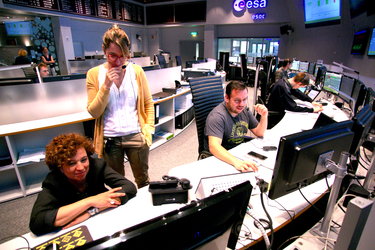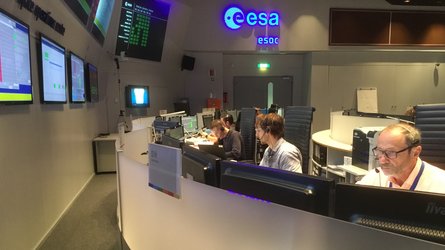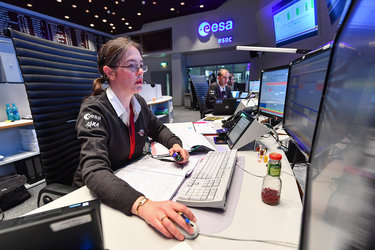Accept all cookies Accept only essential cookies See our Cookie Notice

About ESA
The European Space Agency (ESA) is Europe’s gateway to space. Its mission is to shape the development of Europe’s space capability and ensure that investment in space continues to deliver benefits to the citizens of Europe and the world.
Highlights
ESA - United space in Europe
This is ESA ESA facts Member States & Cooperating States Funding Director General Top management For Member State Delegations European vision European Space Policy ESA & EU Space Councils Responsibility & Sustainability Annual Report Calendar of meetings Corporate newsEstablishments & sites
ESA Headquarters ESA ESTEC ESA ESOC ESA ESRIN ESA EAC ESA ESAC Europe's Spaceport ESA ESEC ESA ECSAT Brussels Office Washington OfficeWorking with ESA
Business with ESA ESA Commercialisation Gateway Law at ESA Careers Cyber resilience at ESA IT at ESA Newsroom Partnerships Merchandising Licence Education Open Space Innovation Platform Integrity and Reporting Administrative Tribunal Health and SafetyMore about ESA
History ESA Historical Archives Exhibitions Publications Art & Culture ESA Merchandise Kids Diversity ESA Brand Centre ESA ChampionsSpace in Member States
Find out more about space activities in our 23 Member States, and understand how ESA works together with their national agencies, institutions and organisations.
Science & Exploration
Exploring our Solar System and unlocking the secrets of the Universe
Go to topicAstronauts
Missions
Juice Euclid Webb Solar Orbiter BepiColombo Gaia ExoMars Cheops Exoplanet missions More missionsActivities
International Space Station Orion service module Gateway Concordia Caves & Pangaea BenefitsSpace Safety
Protecting life and infrastructure on Earth and in orbit
Go to topicAsteroids
Asteroids and Planetary Defence Asteroid danger explained Flyeye telescope: asteroid detection Hera mission: asteroid deflection Near-Earth Object Coordination CentreSpace junk
About space debris Space debris by the numbers Space Environment Report In space refuelling, refurbishing and removingSafety from space
Clean Space ecodesign Zero Debris Technologies Space for Earth Supporting Sustainable DevelopmentLatest
Applications
Using space to benefit citizens and meet future challenges on Earth
Go to topicObserving the Earth
Observing the Earth Future EO Copernicus Meteorology Space for our climate Satellite missionsCommercialisation
ESA Commercialisation Gateway Open Space Innovation Platform Business Incubation ESA Space SolutionsLatest
Enabling & Support
Making space accessible and developing the technologies for the future
Go to topicBuilding missions
Space Engineering and Technology Test centre Laboratories Concurrent Design Facility Preparing for the future Shaping the Future Discovery and Preparation Advanced Concepts TeamSpace transportation
Space Transportation Ariane Vega Space Rider Future space transportation Boost! Europe's Spaceport Launches from Europe's Spaceport from 2012Latest

Concentrated
Thank you for liking
You have already liked this page, you can only like it once!
On 14 March, the BepiColombo flight control team at ESA’s mission control centre in Darmstadt, Germany, was joined by experts from the mission team at the Agency’s technical centre in the Netherlands as well as industry to conduct a ‘system validation test’.
Such tests are critical milestones in getting a spacecraft, its onboard software, the ground systems and the mission control team ready to handle the real flight.
This week, engineers connected their mission control systems to the actual spacecraft, which is now located at ESA’s technical centre, via telecom links, allowing them to ‘talk’ to BepiColombo just as they will after launch when it is in space en route to mercury.
A modern spacecraft has 42 000 telemetry parameters and 2650 control parameters in its software – comparable to a mid-size jet aircraft – and hundreds of thousands of lines of code on board.
BepiColombo, ESA’s first mission to Mercury, has two science craft: ESA’s Mercury Planetary Orbiter, with 11 experiments and instruments, and Japan’s Mercury Magnetospheric Orbiter, with five experiments and instruments.
The spacecraft, along with ground equipment and mission experts, are set to start the move from the Netherlands to Europe’s Spaceport in Kourou, French Guiana at the end of next month. The launch window is open from 5 October until 29 November.
In the photo, in the foreground: Spacecraft Operations Engineer Emanuela Bordoni; centre, Deputy Spacecraft Operations Manager Christoph Steiger; at rear, Susanne Fugger, responsible for BepiColombo operations at Airbus Defence and Space, Germany.
More information
-
CREDIT
ESA -
LICENCE
ESA Standard Licence

Teams at mission control in BepiColombo simulation

ESOC teams complete BepiColombo dress rehearsal

BepiColombo teamwork

Sim training















 Germany
Germany
 Austria
Austria
 Belgium
Belgium
 Denmark
Denmark
 Spain
Spain
 Estonia
Estonia
 Finland
Finland
 France
France
 Greece
Greece
 Hungary
Hungary
 Ireland
Ireland
 Italy
Italy
 Luxembourg
Luxembourg
 Norway
Norway
 The Netherlands
The Netherlands
 Poland
Poland
 Portugal
Portugal
 Czechia
Czechia
 Romania
Romania
 United Kingdom
United Kingdom
 Slovenia
Slovenia
 Sweden
Sweden
 Switzerland
Switzerland
























